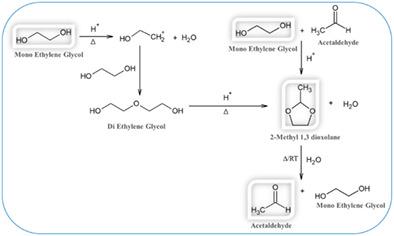当前位置:
X-MOL 学术
›
Polym. Eng. Sci.
›
论文详情
Our official English website, www.x-mol.net, welcomes your
feedback! (Note: you will need to create a separate account there.)
Mechanism of acetaldehyde formation in polyethylene terephthalate resin—A new insight
Polymer Engineering and Science ( IF 3.2 ) Pub Date : 2020-11-17 , DOI: 10.1002/pen.25579 V. S. Mahesh 1 , Kalsang Tharpa 1 , Nitin S. Gadigone 2 , Bander F. Al‐Farhood 2 , Fayez H. Al‐Mutairi 2 , Arun Kumar 1
Polymer Engineering and Science ( IF 3.2 ) Pub Date : 2020-11-17 , DOI: 10.1002/pen.25579 V. S. Mahesh 1 , Kalsang Tharpa 1 , Nitin S. Gadigone 2 , Bander F. Al‐Farhood 2 , Fayez H. Al‐Mutairi 2 , Arun Kumar 1
Affiliation

|
Acetaldehyde is one of the well‐known undesirable by‐product formed during different stages of polyethylene terephthalate manufacturing process. The migration of acetaldehyde from polyethylene terephthalate, even at trace levels of 10–25 ppb is known to adversely impact organoleptic property of water and/or beverages. We are reporting for the first time in‐situ formation of acetaldehyde in polyethylene terephthalate pellets due to the presence of residual levels of 2‐methyl 1, 3‐dioxolane in the final polymer. A new insight on generation of acetaldehyde through hydrolysis of 2‐methyl 1, 3‐dioxolane present in polyethylene terephthalate resin has been established through water spiking studies in a controlled environment. Further, systematic studies were conducted to also understand the mechanism of formation of 2‐methyl 1, 3‐dioxolane during the polyethylene terephthalate manufacturing.
中文翻译:

聚对苯二甲酸乙二醇酯树脂中乙醛形成机理的新见解
乙醛是聚对苯二甲酸乙二醇酯制造过程中不同阶段形成的众所周知的不良副产物之一。乙醛从聚对苯二甲酸乙二醇酯的迁移,即使微量水平为10–25 ppb,也已知会不利地影响水和/或饮料的感官特性。我们首次报道了聚对苯二甲酸乙二醇酯丸粒中乙醛的原位形成,这是由于最终聚合物中残留有2-甲基1、3-二氧戊环。通过在受控环境中进行水钉研究,已经建立了通过水解聚对苯二甲酸乙二醇酯树脂中存在的2-甲基1,3-二氧戊环生成乙醛的新见解。此外,还进行了系统研究,以了解2-甲基1的形成机理
更新日期:2020-11-17
中文翻译:

聚对苯二甲酸乙二醇酯树脂中乙醛形成机理的新见解
乙醛是聚对苯二甲酸乙二醇酯制造过程中不同阶段形成的众所周知的不良副产物之一。乙醛从聚对苯二甲酸乙二醇酯的迁移,即使微量水平为10–25 ppb,也已知会不利地影响水和/或饮料的感官特性。我们首次报道了聚对苯二甲酸乙二醇酯丸粒中乙醛的原位形成,这是由于最终聚合物中残留有2-甲基1、3-二氧戊环。通过在受控环境中进行水钉研究,已经建立了通过水解聚对苯二甲酸乙二醇酯树脂中存在的2-甲基1,3-二氧戊环生成乙醛的新见解。此外,还进行了系统研究,以了解2-甲基1的形成机理











































 京公网安备 11010802027423号
京公网安备 11010802027423号